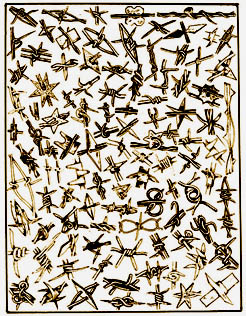Economist, n. a scoundrel whose faulty vision sees things as they really are, not as they ought to be. —after Ambrose Bierce
Joseph Glidden transformed the American Plains. In 1874, Glidden patented the first practical design for barbed wire. The invention dramatically reduced the costs of separating cattle from crops and thus the costs of enforcing property rights to land. Farmers and historians have long been aware of the qualitative importance of barbed wire, but recent research by Richard Hornbeck (2010) makes clear the pivotal role of the invention in the late 19th century settlement of the American Plains.
Cattle wander, and without effective fencing they are so destructive to neighboring crops that cattle and crops cannot coexist. The early colonies adopted legal codes that required farmers to fence out others’ livestock. Without a “lawful fence” a farmer could expect no compensation for damages done by wandering livestock. New states entering the Union continued this legal tradition.
As a practical matter, if farmers wished to protect their crops, fencing was a necessary—and substantial—investment. In 1872, the value of the fencing capital stock in the United States was roughly equal to the value of all livestock. Equivalently, the value of the fencing stock was as great as the national debt or the value of all railroads in the United States. In fact, annual fencing repair costs exceeded the combined tax receipts of all levels of government.
Wood had long been the fencing material of choice in America. But as settlers began moving into western Minnesota, west Texas, Kansas, Nebraska, and farther west, they found that a lack of woodlands, plus high transport costs, made fencing prohibitively expensive across wide areas. As a practical matter, it was not economically viable to settle in an area unless it happened to have a local timber plot. In effect, although Plains farmers had secure property rights to the physical land, because they could not protect their crops from cattle and other livestock, property rights in the economic value of their lands were sharply attenuated. As early as the 1840s, the lack of timber throughout the Plains was recognized as the single most important barrier to settlement.
Glidden’s invention eliminated that barrier and quickly changed the settlement calculus. The barbs prevented cattle from breaking the fence, and the steel wire was relatively weather-resistant. Moreover, Glidden’s design was cheap to manufacture and, compared to wood, it had lower labor requirements for installation and repair. Within short order, barbed wire came to dominate fencing and to transform the economic decisions of settlers.
In 1874, five tons of barbed wire were produced; in 1880, 40,000 tons were manufactured; and by the turn of the century, annual production had reached 200,000 tons. This rapid rise in sales was stimulated in part by the practical superiority of wire. But it was accelerated by manufacturing improvements and falling steel prices, which together drove the price of barbed wire from $20 per hundred pounds in 1874, to $10 in 1880, and under $2 by 1897. By 1910, not only had fencing stocks in the prairie states increased more than tenfold, wooden fences had essentially disappeared.
Barbed wire changed settlers’ decision-making in a variety of ways. First, it made it economically feasible to settle lands without regard to proximity to timber stands. Thus, the total amount of land settled rose. Second, the lower-cost fencing increased the incentives of farmers to invest in quality-enhancing improvements to their lands. And third, the invention changed the choice of crops. Low-value hay, for example, is relatively resistant to livestock damage before being harvested, and hay fields can even be intentionally used for grazing at certain times of the year. In contrast, high-value crops such as corn, wheat, oats, barley, and rye are much more vulnerable to livestock damage. The spread of barbed wire enabled farmers to shift more of their lands to these higher value crops and raised productivity on land by roughly 30 percent.
It will come as little surprise, then, that barbed wire also caused a rapid and substantial rise in the value of land across the Plains. Hornbeck estimates that between 1880 and 1890, barbed wire caused the value of farmlands in the Plains to increase by 50 percent. His findings imply that the rise in farmland values over this period may have amounted to as much as 3 percent of total U.S. gross domestic product.
There is growing evidence from developing countries around the world, and even from Indian reservations in the United States, that insecure property rights limit economic development. In the middle of the nineteenth century, the development of American agriculture was similarly limited when Plains farmers were unable to protect frontier lands from encroachment by livestock, especially cattle. What makes the barbed wire episode so intriguing is that this conflict over resource use—between crops and livestock—was resolved not by lawsuit or even by legal reform. It was instead resolved by an entrepreneur who sought to solve a specific problem of enforcing property rights—and succeeded spectacularly. It is a lesson worth remembering as we seek solutions to todays conflicts over the use of environmental resources.
REFERENCE
Hornbeck, Richard. 2010. “Barbed Wire: Property Rights and Agricultural Development.” Quarterly Journal of Economics, 125 (2): 767–810.




